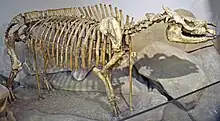| Trigonias | |
|---|---|
 | |
| T. osborni | |
| Scientific classification | |
| Domain: | Eukaryota |
| Kingdom: | Animalia |
| Phylum: | Chordata |
| Class: | Mammalia |
| Order: | Perissodactyla |
| Family: | Rhinocerotidae |
| Genus: | †Trigonias Lucas, 1900 |
| Type species | |
| †Trigonias osborni | |
| Species[2] | |
| |
| Synonyms | |
| |
Trigonias (Greek: "triangular" (trigonos), "ias" [denotes possession][3]) is an extinct genus of rhinocerotid from the late Eocene (Chadronian) some 35 million years ago of North America.[4] Trigonias was about 2.1 metres (6 ft 11 in) long and, despite lacking horns, looked a lot like modern rhinos. Its front legs had five toes (as contrasted with three in modern rhinos), the fifth of which was vestigial.[5]
A specimen of T. osborni was estimated to have a weight of about 391 kilograms (862 lb).[6]
Notes
- ↑ Prothero, 2005, p. 184.
- 1 2 Prothero, 2005, pp. 35-37.
- ↑ "Glossary. American Museum of Natural History". Archived from the original on 20 November 2021.
- ↑ Prothero, 2005
- ↑ Palmer, D., ed. (1999). The Marshall Illustrated Encyclopedia of Dinosaurs and Prehistoric Animals. London: Marshall Editions. p. 264. ISBN 1-84028-152-9.
- ↑ http://paleodb.org/cgi-bin/bridge.pl?a=basicTaxonInfo&taxon_no=52444
References
- Prothero, Donald R. 2005. The Evolution of North American Rhinoceroses. Cambridge University Press, Cambridge, 218 pp. ISBN 0-521-83240-3
This article is issued from Wikipedia. The text is licensed under Creative Commons - Attribution - Sharealike. Additional terms may apply for the media files.